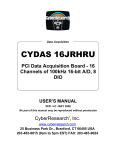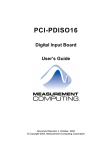Download Manual - eConceptOnline
Transcript
PCI-DAS08 Analog input and Digital I/O User’s Guide Document Revision 4, May, 2005 © Copyright 2005, Measurement Computing Corporation Your new Measurement Computing product comes with a fantastic extra — Management committed to your satisfaction! Refer to www.mccdaq.com/execteam.html for the names, titles, and contact information of each key executive at Measurement Computing. Thank you for choosing a Measurement Computing product—and congratulations! You own the finest, and you can now enjoy the protection of the most comprehensive warranties and unmatched phone tech support. It’s the embodiment of our two missions: To offer the highest-quality, computer-based data acquisition, control, and GPIB hardware and software available—at the best possible price. To offer our customers superior post-sale support—FREE. Whether providing unrivaled telephone technical and sales support on our latest product offerings, or continuing that same first-rate support on older products and operating systems, we’re committed to you! Lifetime warranty: Every hardware product manufactured by Measurement Computing Corporation is warranted against defects in materials or workmanship for the life of the product. Products found defective are repaired or replaced promptly. Lifetime Harsh Environment Warranty®: We will replace any product manufactured by Measurement Computing Corporation that is damaged (even due to misuse) for only 50% of the current list price. I/O boards face some tough operating conditionssome more severe than the boards are designed to withstand. When a board becomes damaged, just return the unit with an order for its replacement at only 50% of the current list price. We don’t need to profit from your misfortune. By the way, we honor this warranty for any manufacturer’s board that we have a replacement for. 30 Day Money Back Guarantee: You may return any Measurement Computing Corporation product within 30 days of purchase for a full refund of the price paid for the product being returned. If you are not satisfied, or chose the wrong product by mistake, you do not have to keep it. Please call for an RMA number first. No credits or returns accepted without a copy of the original invoice. Some software products are subject to a repackaging fee. These warranties are in lieu of all other warranties, expressed or implied, including any implied warranty of merchantability or fitness for a particular application. The remedies provided herein are the buyer’s sole and exclusive remedies. Neither Measurement Computing Corporation, nor its employees shall be liable for any direct or indirect, special, incidental or consequential damage arising from the use of its products, even if Measurement Computing Corporation has been notified in advance of the possibility of such damages. HM PCI-DAS08.doc ii Trademark and Copyright Information TracerDAQ, InstaCal, Universal Library, Harsh Environment Warranty, Measurement Computing Corporation, and the Measurement Computing logo are either trademarks or registered trademarks of Measurement Computing Corporation. SoftWIRE is a registered trademark of SoftWIRE Technology, Inc. Windows, Microsoft, and Visual Studio are either trademarks or registered trademarks of Microsoft Corporation. LabVIEW is a trademark of National Instruments. All other trademarks are the property of their respective owners. Information furnished by Measurement Computing Corporation is believed to be accurate and reliable. However, no responsibility is assumed by Measurement Computing Corporation neither for its use; nor for any infringements of patents or other rights of third parties, which may result from its use. No license is granted by implication or otherwise under any patent or copyrights of Measurement Computing Corporation. All rights reserved. No part of this publication may be reproduced, stored in a retrieval system, or transmitted, in any form by any means, electronic, mechanical, by photocopying, recording, or otherwise without the prior written permission of Measurement Computing Corporation. Notice Measurement Computing Corporation does not authorize any Measurement Computing Corporation product for use in life support systems and/or devices without the written approval of the CEO of Measurement Computing Corporation. Life support devices/systems are devices or systems which, a) are intended for surgical implantation into the body, or b) support or sustain life and whose failure to perform can be reasonably expected to result in injury. Measurement Computing Corporation products are not designed with the components required, and are not subject to the testing required to ensure a level of reliability suitable for the treatment and diagnosis of people. iii Table of Contents Preface About this User's Guide .......................................................................................................................v What you will learn from this user's guide .........................................................................................................v Conventions in this user's guide .........................................................................................................................v Where to find more information........................................................................................................................vi Chapter 1 Introducing the PCI-DAS08 .............................................................................................................. 1-1 Overview: PCI-DAS08 features ..................................................................................................................... 1-1 Software features ............................................................................................................................................ 1-2 Chapter 2 Installing the PCI-DAS08 .................................................................................................................. 2-1 What comes with your shipment? .................................................................................................................. 2-1 Hardware ....................................................................................................................................................................... 2-1 Software......................................................................................................................................................................... 2-1 Documentation............................................................................................................................................................... 2-1 Optional components ..................................................................................................................................................... 2-2 Unpacking the board ...................................................................................................................................... 2-2 Installing the software .................................................................................................................................... 2-3 Installing the hardware ................................................................................................................................... 2-3 Configuring the hardware............................................................................................................................... 2-3 Connecting the board for I/O operations ........................................................................................................ 2-4 Connectors, cables – main I/O connector ...................................................................................................................... 2-4 Field wiring, signal termination and signal conditioning............................................................................................... 2-5 Chapter 3 Programming and Developing Applications .................................................................................. 3-1 Programming languages ................................................................................................................................. 3-1 Packaged application programs ...................................................................................................................... 3-1 Register-level programming ........................................................................................................................... 3-1 Chapter 4 Specifications.................................................................................................................................... 4-1 Analog input ................................................................................................................................................... 4-1 Digital input / output ...................................................................................................................................... 4-2 Counter section............................................................................................................................................... 4-2 Power consumption ........................................................................................................................................ 4-3 Environmental ................................................................................................................................................ 4-3 Main connector and pin out............................................................................................................................ 4-3 iv Preface About this User's Guide What you will learn from this user's guide This user's guide explains how to install, configure, and use the PCI-DAS08 so that you get the most out of the analog input and digital I/O features. This user's guide also refers you to related documents available on our web site, and to technical support resources. Conventions in this user's guide For more information on … Text presented in a box signifies additional information and helpful hints related to the subject matter you are reading. Caution! Shaded caution statements present information to help you avoid injuring yourself and others, damaging your hardware, or losing your data. <#:#> Angle brackets that enclose numbers separated by a colon signify a range of numbers, such as those assigned to registers, bit settings, etc. bold text Bold text is used for the names of objects on the screen, such as buttons, text boxes, and check boxes. For example: 1. Insert the disk or CD and click the OK button. italic text Italic text is used for the names of manuals and help topic titles, and to emphasize a word or phrase. For example: The InstaCal installation procedure is explained in the DAQ Software Quick Start. Never touch the exposed pins or circuit connections on the board. v PCI-DAS08 User's Guide About this User's Guide Where to find more information The following electronic documents provide information that is relevant to the operation of the PCIDAS08. The Specifications: PCI-DAS08 (the PDF version of Chapter 4 in this guide) is available on our web site at www.mccdaq.com/pdfs/PCI-DAS08.pdf. The Register Map for the PCI-DAS08 is available on our web site at www.mccdaq.com/registermaps/RegMapPCI-DAS08.pdf. MCC's DAQ Software Quick Start is available on our web site at www.mccdaq.com/PDFmanuals/DAQ-Software-Quick-Start.pdf. MCC's Guide to Signal Connections is available on our web site at www.mccdaq.com/signals/signals.pdf. The Universal Library User's Guide is available on our web site at www.mccdaq.com/PDFmanuals/sm-ul-user-guide.pdf. The Universal Library Function Reference is available on our web site at www.mccdaq.com/PDFmanuals/sm-ul-functions.pdf. MCC's Universal Library for LabVIEW™ User’s Guide is available on our web site at www.mccdaq.com/PDFmanuals/SM-UL-LabVIEW.pdf. This user's manual is also available on our web site at www.mccdaq.com/PDFmanuals/PCI-DAS08.pdf. vi Chapter 1 Introducing the PCI-DAS08 Overview: PCI-DAS08 features This manual explains how to configure, install, and use your PCI-DAS08 board. The PCI-DAS08 is a multifunction measurement and control board designed to operate in computers with PCI bus accessory slots. The PCI-DAS08 board provides the following features: Eight single-ended 12-bit analog inputs 12-bit A/D resolution Sample rates of up to 40 kHz ±5V input range Three 16-bit counters Seven digital I/O bits (three input, four output) Connector compatible with Measurement Computing’s ISA-based CIO-DAS08 board The PCI-DAS08 board is completely plug-and-play compliant, with no switches or jumpers to set. Configuration is controlled by your system's plug-and-play software. A functional block diagram of the PCI-DAS08 is shown here. Buffer 10 Volt Reference Gain and Offset Cal Buffer Analog In 8 CH S.E. 12-bit, 100 kHz Mux Start EOC A/D Control Channel Select 82C54 16-bit Counters Gate2 Output Clock2 Counter 0 Counter 1 Controller FPGA and Logic Control Input Clock0 Gate0 Output Clock0 Input Clock1 Gate1 Output Clock1 ADC and MUX Control Counter 2 Counter 2 Clock Input Clock2 (33 MHz/8) Output Port Control Output (3:0) Input Port Interrupt Control Output Clock2 EXT_INT Decode/Status Digital I/O Input (2:0) Channel Select Bus Timing LOCAL BUS Boot EEPROM PCI Controller BADR1 BADR2 Interrupt PCI BUS (5 V, 32-BIT, 33 MHZ) Figure 1-1. PCI-DAS08 block diagram 1-1 PCI-DAS08 User's Guide Introducing the PCI-DAS08 Software features The following software ships with the PCI-DAS08 free of charge. InstaCal installation, calibration, and test utility TracerDAQ™ suite of virtual instruments SoftWIRE® for Visual Studio® .NET graphical programming MCC DAQ Components for VS .NET (installed with SoftWIRE® for VS .NET) For information on the features of InstaCal, TracerDAQ, and SoftWIRE, refer to the DAQ Software Quick Start booklet that ships with the PCI-DAS08. 1-2 Chapter 2 Installing the PCI-DAS08 What comes with your shipment? As you unpack your board, make sure each of the items shown below is included: Hardware PCI-DAS08 Software The Measurement Computing Data Acquisition Software CD contains the following software: InstaCal installation, calibration, and test utility TracerDAQ™ suite of virtual instruments SoftWIRE® for VS .NET SoftWIRE MCC DAQ Components for .NET Documentation In addition to this hardware user's guide, you should also receive the DAQ Software Quick Start (available in PDF at www.mccdaq.com/PDFmanuals/DAQ-Software-Quick-Start.pdf). Please read this booklet completely before installing any software and hardware. 2-1 PCI-DAS08 User's Guide Installing the PCI-DAS08 Optional components If you ordered any of the following products with your board, they should be included with your shipment. Universal Library Universal Library™ Data Acquisition and Control Programming Tools (also includes the InstaCal utility, the Universal Library User's Guide, and the Universal Library Function Reference) Cables C37FF-x C37FFS-x Signal termination and conditioning accessories MCC provides signal termination products for use with the PCI-DAS08. Refer to the "Field wiring, signal termination and signal conditioning" section for a complete list of compatible accessory products. Unpacking the board The PCI-DAS08 boards are shipped in an antistatic container to prevent damage by an electrostatic discharge. To avoid such damage, perform the following procedure when unpacking and handling your board. 1. Before opening the antistatic container, ground yourself with a wrist-grounding strap or by holding onto a grounded object. 2. Touch the antistatic container to the computer chassis before removing the board from the container. 3. Remove the board from the container. Never touch the exposed pins or circuit connections on the board. If your board is damaged, notify Measurement Computing Corporation immediately by phone, fax, or email. For international customers, contact your local distributor where you purchased the board. Phone: 508-946-5100 and follow the instructions for reaching Tech Support. Fax: 508-946-9500 to the attention of Tech Support 2-2 PCI-DAS08 User's Guide Installing the PCI-DAS08 Email: [email protected] Installing the software Install the software included with your board before you install the hardware. Installing the software first ensures that the information required for proper board detection is installed and available at boot up. Refer to the DAQ Software Quick Start for instructions on installing the software on the Measurement Computing Data Acquisition Software CD. This booklet is shipped with the hardware, and is also available in PDF at www.mccdaq.com/PDFmanuals/DAQ-Software-Quick-Start.pdf. Installing the hardware The PCI-DAS08 board is completely plug-and-play, with no switches or jumpers to set. Configuration is controlled by your system's BIOS. To install your board, follow the steps below. Install the MCC DAQ software before you install your board The driver needed to run your board is installed with the MCC DAQ software. Therefore, you need to install the MCC DAQ software before you install your board. Refer to the DAQ Software Quick Start for instructions on installing the software. 1. Turn your computer off, remove the cover, and insert your board into an available PCI slot. 2. Close your computer and turn it on. If you are using an operating system with support for plug-and-play (such as Windows 2000 or Windows XP), a dialog box displays as the system loads, indicating that new hardware has been detected. If the information file for this board is not already loaded onto your PC, you are prompted for the disk containing this file. The Measurement Computing Data Acquisition Software CD supplied with your board contains this file. If required, insert the disk or CD and click OK. 3. To test your installation and configure your board, run the InstaCal utility you installed in the previous section. Refer to the DAQ Software Quick Start that came with your board (www.mccdaq.com/PDFmanuals/DAQ-Software-Quick-Start.pdf) for information on how to initially set up and load InstaCal. 4. If your board has been powered-off for more than 10 minutes, allow your computer to warm up for at least 15 minutes before acquiring data. This warm-up period is required for the board to achieve its rated accuracy. The high speed components used on the board generate heat, and it takes this amount of time for a board to reach steady state if it has been powered off for a significant amount of time. Configuring the hardware All of the hardware configuration options on the PCI-DAS08 are software controlled. You can select some of the configuration options using InstaCal, such as the counter source and interrupt source. Once selected, any program that uses the Universal Library will initialize the hardware according to these selections. Information on signal connections General information regarding signal connection and configuration is available in the Guide to Signal Connections. This document is available at http://www.measurementcomputing.com/signals/signals.pdf. 2-3 PCI-DAS08 User's Guide Installing the PCI-DAS08 Connecting the board for I/O operations Connectors, cables – main I/O connector Table 2-1 lists the board connectors, applicable cables and compatible accessory boards. Table 2-1. Board Connectors, cables, accessory equipment Connector type Compatible cables Compatible accessory products (with the C37FF-x cable) Compatible accessory products (with the C37FFS-x cable) 37-pin male "D" connector C37FF-x 37-pin cable. x = length in feet (Figure 2-2). C37FFS-x 37-pin shielded cable. x = length in feet (Figure 2-3). CIO-MINI37 SCB-37 ISO-RACK08 CIO-MINI37 SCB-37 ISO-RACK08 CIO-EXP16 CIO-EXP32 CIO-EXP-GP CIO-EXP-BRIDGE16 CIO-EXP-RTD16 -12V CTR1 GATE CTR2 GATE CTR3 GATE EXT INT DIN1 DIN2 DIN3 DGND +5V CH7 CH6 CH5 CH4 CH3 CH2 CH1 CH0 CTR1 CLK CTR1 OUT CTR2 CLK CTR2 OOUT CTR3 OUT DOUT1 DOUT2 DOUT3 DGND LLGND LLGND LLGND LLGND LLGND LLGND LLGND Figure 2-1. 37-pin connector pinout The red stripe identifies pin # 1 1 1 20 20 37 37 19 19 Figure 2-2. C37FF-x cable 2-4 PCI-DAS08 User's Guide 1 19 Installing the PCI-DAS08 1 20 37 19 20 37 Figure 2-3. C37FFS-x cable Caution! If either the AC or DC voltage is greater than 5 volts, do not connect the PCI-DAS08 to this signal source. You are beyond the board's usable input range and will need to either adjust your grounding system or add special isolation signal conditioning to take useful measurements. A ground offset voltage of more than 7 volts may damage the PCI-DAS08 board and possibly your computer. An offset voltage much greater than 7 volts will damage your electronics, and may be hazardous to your health. Field wiring, signal termination and signal conditioning You can use the following MCC screw terminal boards to terminate field signals and route them into the PCI-DAS08 board using the C37FF-x or C37FFS-x cable: CIO-MINI37 – 37-pin screw terminal board. Details on this product are available at www.mccdaq.com/cbicatalog/cbiproduct.asp?dept_id=102&pf_id=255. SCB-37 – 37 conductor, shielded signal connection/screw terminal box that provides two independent 50-pin connections. Details on this product are available at www.mccdaq.com/cbicatalog/cbiproduct.asp?dept_id=196&pf_id=1166. MCC provides the following analog signal conditioning products for use with your PCI-DAS08 board: ISO-RACK08 – Isolated 8-channel, 5B module rack for analog signal conditioning and expansion. Details on this product are available on our web site at www.mccdaq.com/cbicatalog/cbiproduct.asp?dept_id=127&pf_id=449. CIO-EXP16 – 16-channel analog multiplexer board with on-board CJC sensor. Details on this product are available on our web site at www.mccdaq.com/cbicatalog/cbiproduct.asp?dept_id=126&pf_id=249. CIO-EXP32 – 32-channel analog multiplexer board with on-board CJC sensor and 2 Gain amps. Details on this product are available on our web site at www.mccdaq.com/cbicatalog/cbiproduct.asp?dept_id=126&pf_id=250. CIO-EXP-GP – 8-channel expansion multiplexer board with resistance signal conditioning. Details on this product are available on our web site at www.mccdaq.com/cbicatalog/cbiproduct.asp?dept_id=126&pf_id=244. CIO-EXP-BRIDGE16 – 16-channel expansion multiplexer board with Wheatstone bridge signal conditioning. Details on this product are available on our web site at www.mccdaq.com/cbicatalog/cbiproduct.asp?dept_id=126&pf_id=243. CIO-EXP-RTD16 – 16-channel expansion multiplexer board with RTD signal conditioning. Details on this product are available on our web site at www.mccdaq.com/cbicatalog/cbiproduct.asp?dept_id=126&pf_id=248. 2-5 Chapter 3 Programming and Developing Applications After following the installation instructions in Chapter 2, your board should now be installed and ready for use. Although the board is part of the larger DAS family, there is no correspondence among registers for different boards. Software written at the register level for other DAS models will not function correctly with the PCI-DAS08 board. Programming languages Measurement Computing’s Universal Library™ provides access to board functions from a variety of Windows programming languages. If you are planning to write programs, or would like to run the example programs for Visual Basic or any other language, refer to the Universal Library User's Guide (available on our web site at www.mccdaq.com/PDFmanuals/sm-ul-user-guide.pdf). Packaged application programs Many packaged application programs, such as SoftWIRE, Labtech Notebook™, and HP-VEE™, now have drivers for your board. If the package you own does not have drivers for the board, please fax or email the package name and the revision number from the install disks. We will research the package for you and advise how to obtain drivers. Some application drivers are included with the Universal Library package, but not with the application package. If you have purchased an application package directly from the software vendor, you may need to purchase our Universal Library and drivers. Please contact us by phone, fax or e-mail: Phone: 508-946-5100 and follow the instructions for reaching Tech Support. Fax: 508-946-9500 to the attention of Tech Support Email: [email protected] Register-level programming You should use the Universal Library or one of the packaged application programs mentioned above to control your board. Only experienced programmers should try register-level programming. If you need to program at the register level in your application, you can find more information in the Register Map for the PCI-DAS08 Series (available at www.mccdaq.com/registermaps/RegMapPCIDAS08.pdf). 3-1 Chapter 4 Specifications Typical for 25 °C unless otherwise specified. Specifications in italic text are guaranteed by design. Analog input Table 4-1. Analog input specifications Parameter Specification A/D converter type Resolution Ranges A/D pacing A/D triggering modes AD1674J 12 bits ±5 V Software polled Digital: Software polling of digital input (DIN1) followed by pacer loading and configuration. Software polled Bipolar 8 single-ended 10 µs 40 kHz typical, PC dependent ±1 LSB No missing codes guaranteed ±1 LSB ±180 ppm/°C ±60 ppm/°C ±60 nA max over temperature 10 MegOhm min ±35 V (Rate = 1-50 kHz, Average % ± 2 bins, Average % ± 1 bin, Average # bins) Bipolar (5 V): 100% / 100% / 3 bins Data transfer Polarity Number of channels A/D conversion time Throughput Relative accuracy Differential linearity error Integral linearity error Gain drift (A/D specs) Zero drift (A/D specs) Input leakage current Input impedance Absolute maximum input voltage Noise distribution 4-1 PCI-DAS08 User's Guide Specifications Digital input / output Table 4-2. Digital I/O specifications Parameter Digital type (main connector): Output Input Configuration Number of channels Output high Output low Input high Input low Interrupts Interrupt enable Interrupt sources Specification 74ACT273 74LS244 3 fixed input, 4 fixed output 7 3.94 volts min @ -24 mA (Vcc = 4.5 V) 0.36 volts max @ 24 mA (Vcc = 4.5 V) 2.0 volts min, 7 volts absolute max 0.8 volts max, -0.5 volts absolute min INTA# - mapped to IRQn via PCI BIOS at boot-time Programmable through PCI controller: 0 = disabled, 1 = enabled (default) External source (EXT INT) Polarity programmable through PCI controller: 1 = active high, 0 = active low (default) Counter section Table 4-3. Counter specifications Parameter Specification Counter type Configuration Counter 0 - User counter 1 82C54 device 3 down counters, 16-bits each Source: Available at user connector (CTR1CLK) Gate: Available at user connector (CTR1GATE) Output: Available at user connector (CTR1OUT) Source: Available at user connector (CTR2CLK) Gate: Available at user connector (CTR2GATE) Output: Available at user connector (CTR2OUT) Source: Buffered PCI clock (33 MHz) divided by 8. Gate: Available at user connector (CTR3GATE) Output: Available at user connector (CTR3OUT) and may be software configured as Interrupt Pacer. 10 MHz max 30 ns min 50 ns min 50 ns min 50 ns min 0.8 V max 2.0 V min 0.4 V max 3.0 V min Counter 1 - User counter 2 Counter 2 - User counter 3 or Interrupt Pacer Clock input frequency High pulse width (clock input) Low pulse width (clock input) Gate width high Gate width low Input low voltage Input high voltage Output low voltage Output high voltage 4-2 PCI-DAS08 User's Guide Specifications Power consumption Table 4-4. Power consumption specifications Parameter Specification +5 V operating (A/D converting to FIFO) +12 V -12 V 251 mA typical, 436 mA max 13 mA typical, 19 mA max 17 mA typical, 23 mA max Environmental Table 4-5. Environmental specifications Parameter Specification Operating temperature range Storage temperature range Humidity 0 to 50 °C -20 to 70 °C 0 to 90% non-condensing Main connector and pin out Table 4-6. Main connector specifications Parameter Specification Connector type Compatible cables 37-pin male "D" connector C37FF-x cable C37FFS-x cable CIO-MINI37 SCB-37 ISO-RACK08 CIO-MINI37 SCB-37 ISO-RACK08 CIO-EXP16 CIO-EXP32 CIO-EXP-GP CIO-EXP-BRIDGE16 CIO-EXP-RTD16 Compatible accessory products (with C37FF-x cable) Compatible accessory products (with C37FFS-x cable) 4-3 PCI-DAS08 User's Guide Specifications Table 4-7. Main connector pin out Pin Signal Name Pin Signal Name 1 2 3 4 5 6 7 8 9 10 11 12 13 14 15 16 17 18 19 +12V CTR1 CLK CTR1 OUT CTR2 CLK CTR2 OUT CTR3 OUT DOUT1 DOUT2 DOUT3 DOUT4 DGND LLGND LLGND LLGND LLGND LLGND LLGND LLGND 10V REF 20 21 22 23 24 25 26 27 28 29 30 31 32 33 34 35 36 37 -12V CTR1 GATE CTR2 GATE CTR3 GATE EXT IN DIN1 DIN2 DIN3 DGND +5V CH7 CH6 CH5 CH4 CH3 CH2 CH1 CH0 4-4 EC Declaration of Conformity We, Measurement Computing Corporation, declare under sole responsibility that the product PCI-DAS08 Part Number Low cost analog input and digital I/O board for the PCI bus Description to which this declaration relates, meets the essential requirements, is in conformity with, and CE marking has been applied according to the relevant EC Directives listed below using the relevant section of the following EC standards and other informative documents: EU EMC Directive 89/336/EEC: Essential requirements relating to electromagnetic compatibility. EN 55022 Class B (1995): Radiated and conducted emission requirements for information technology equipment. ENV 50204 (1995): Radio-frequency electromagnetic field immunity. EN 55024 (1998): EC generic immunity requirements. EN50082-1 (1997): EC generic immunity requirements. EN 61000-4-2 (1995): Electrostatic discharge immunity. EN 61000-4-3 (1997) ENV 50204 (1996): RF immunity. EN 61000-4-4 (1995): Electric fast transient burst immunity. EN 61000-4-5 (1995): Surge immunity. EN 61000-4-6 (1996): Radio frequency common mode immunity. EN 61000-4-8 (1994): Power frequency magnetic field immunity. EN 61000-4-11 (1994): Voltage dip and interrupt immunity. Carl Haapaoja, Vice-President of Design Verification Measurement Computing Corporation 16 Commerce Boulevard, Middleboro, Massachusetts 02346 (508) 946-5100 Fax: (508) 946-9500 E-mail: [email protected] www.mccdaq.com





















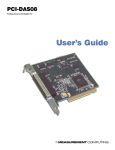

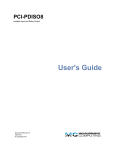
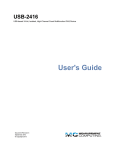
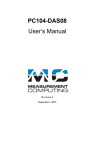
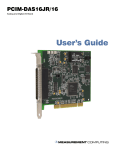
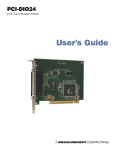
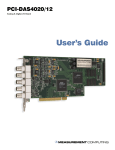
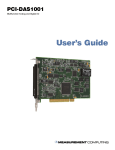
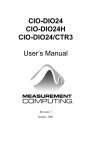
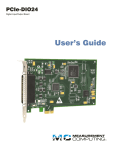

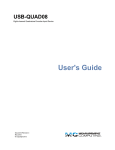
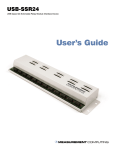
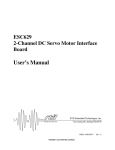
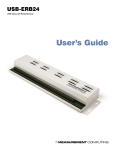

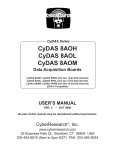
![EX MV MX3 User Manual [May16].vp](http://vs1.manualzilla.com/store/data/005646159_1-0d378a1c318c2dc00419aef6af60da73-150x150.png)

